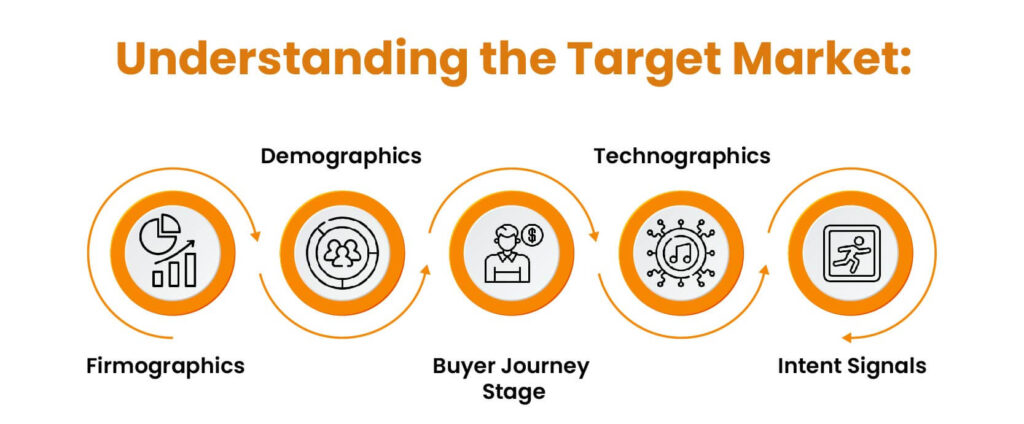
Whether you are launching a product or updating an existing go-to-market strategy, your organization needs a solid GTM strategy to reach the right audience, drive revenue, and sustain economic challenges. To achieve this, you require a meticulously crafted actionable go-to-market plan.
Crafting a successful B2B GTM strategy is easier said than done, but with the right framework, it becomes achievable. This strategic approach prevents you from targeting the wrong audience and wasting resources on unsuccessful campaigns. However, before delving into the essential strategies for a successful GTM approach, it’s crucial to grasp the basics.
What is GTM in B2B Marketing?
Table of Contents
GTM in B2B is the marketing plan created by your company to reach the right market for finding the right audience at the right time. This includes detailed identification of the target accounts that are looking for your solutions.
By conducting comprehensive analyses of market trends and customer needs, your sales and marketing team customizes campaigns to align with your offerings.
Through this process, the optimal product positioning in the market is established, alongside identifying crucial KPIs to evaluate campaign effectiveness.
Now let’s see how you can create a successful B2B go-to-market strategy:
Understanding the Target Market:

A successful GTM strategy requires a deep understanding of the market to narrow down the target market. This entails conducting extensive market research to recognize challenges and opportunities, thereby positioning your offering as the solution. The profile goes beyond demographics and includes parameters like:
Firmographics:
Company size, growth rate, revenue, business type.
Demographics:
Understanding the decision-makers (CMO, CFO, IT director) within the company influencing purchasing decisions for your offerings.
Buyer Journey Stage:
The B2B buyer journey includes multiple stakeholders at each stage (awareness, consideration, decision). Tailoring the communication addressing them is crucial for conversion.
Technographics:
Knowing the technology stack and software of your target companies allows you to tailor the messaging that aligns with their compatibility and integration capabilities.
Intent Signals:
Identify and track the accounts that are researching your offerings or similar offerings that your competitors are offering. Keeping these attributes in mind, marketers and sales should team up to create a list of accounts to target and prioritize.
Positioning Your Offering in the Market:
Now that you understand the target market, it’s time to position the product that defines you from the competitors to potential customers.
Communicate Unique Value Proposition (UVP)
Start by identifying your Unique Value Proposition (UVP), which should effectively communicate the benefits and address the pain points of your customers.
By aligning your product or services with value matrices based on key features and benefits, showcase how you stand out. For instance, positioning yourself as the most secure and user-friendly platform compared to competitors can leave a lasting impression on prospects.
Crafting Clear Messages:
Content marketing is key here. With a solid understanding of your audience and a well-defined UVP, crafting a compelling message is the next step. Your UVP is the clear message communicating the benefits to be delivered and addressing the pain points. And crafting a compelling message that clearly brings value.
Understand Buyer’s Journey:
As we know, B2B buyers are risk-averse, so it’s a great idea to provide solutions by tracking their journey. This involves offering the solutions they seek at each stage of their journey. Focus on addressing the challenges, delivering tangible benefits, and showcasing how your product improves their bottom line.
As prospects search the internet for data-driven insights and practical strategies, you can produce valuable content such as blog posts, white papers, case studies, and webinars. Not only does valuable content nurture the audience, but it also establishes you as a thought leader and most importantly attracts qualified leads (potential customers who meet your ideal buyer persona profile).
Choosing the Right Channels
Selecting the most effective marketing and sales channels to reach your target audience is critical for maximizing the impact of your GTM strategy. The B2B marketing landscape offers a broad range of channels, each with its strengths and weaknesses.
Here’s a brief guide to choose the right channel:
Know Your Audience: Understand your target audience’s demographics, behavior, and preferences.
Identify Buyer Personas: Develop detailed profiles of your ideal customers to guide your channel selection.
Evaluate Options: Research traditional and digital channels, considering factors like reach, engagement, and cost-effectiveness.
Align with Goals: Ensure your chosen channels support your business objectives, whether it’s brand awareness, lead generation, or customer acquisition.
Tailor Your Approach: Adapt your messaging and content to fit each channel’s characteristics and audience.
Use a Multi-Channel Approach: Combine online and offline channels to create an integrated marketing strategy.
Monitor and Adjust: Continuously track channel performance and be ready to adjust your strategy based on results.
Leveraging Account-based Marketing (ABM)
Account-based marketing focuses on nurturing relationships with high-value accounts – particularly relevant for B2B organizations with large, complex sales cycles.
The choice of the optimal channel mix depends on your budget, target audience (as defined by your buyer personas), and industry. Consider where your ideal customers spend their time online and offline to tailor your approach and maximize their exposure to your message.
Aligning Sales and Marketing:
Converting leads into customers a GTM strategy doesn’t end with lead generation. Equally important is converting those leads into loyal customers.
This requires aligning your sales strategy seamlessly with your marketing efforts. Leads nurtured through valuable content and targeted outreach should be passed to qualified salespeople who understand their specific needs and pain points.
Effective lead nurturing involves building relationships through personalized communication and addressing their concerns throughout the buying journey.
Sales enablement plays a critical role in converting leads. Equipping your sales team with the necessary resources, including product training, sales collateral, and competitive intelligence, empowers them to present compelling solutions to potential customers.
Conclusion:
In conclusion, crafting a winning go-to-market strategy in B2B marketing requires a comprehensive approach that encompasses market understanding, effective positioning, clear messaging, channel selection, and seamless alignment between sales and marketing efforts.
Ready to elevate your B2B GTM strategy? Implement the insights shared in this guide to drive success and achieve your business objectives effectively.

Vikas Bhatt is the Co-Founder of ONLY B2B, a premium B2B lead generation company that specializes in helping businesses achieve their growth objectives through targeted marketing & sales campaigns. With 10+ years of experience in the industry, Vikas has a deep understanding of the challenges faced by businesses today and has developed a unique approach to lead generation that has helped clients across a range of industries around the globe. As a thought leader in the B2B marketing community, ONLY B2B specializes in demand generation, content syndication, database services and more.


